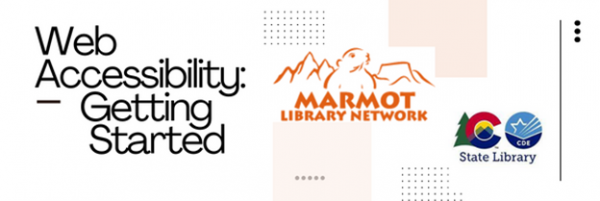
While the specifics of Colorado’s web accessibility laws are ironed out, Marmot and the State Library have collected some tools and suggestions to help you navigate through the changes. This is not exhaustive or final, just a starting point.
Planning/Administration/Budget
- Publish both an Accessibility Policy and an Accessibility Statement that have been approved by your library’s governing entity. Here are some ideas:
- Accessibility policies can be simple statements that outline how your library creates, manages, and delivers accessible web content. See Developing Organizational Policies on Web Accessibility for some examples.
- An Accessibility Statement describes to library users your library’s commitment to accessibility, the specific standards applied to your library’s web presence, and gives contact information for any accessibility issues users might find on your library’s website. See Developing an Accessibility Statement | Web Accessibility Initiative (WAI) | W3C for a tool that can generate an Accessibility Statement. For an example, see the Colorado Virtual Library’s sample.
- Develop a budget for the tools and resources your library may need in order to make files and events accessible following July 1, 2024. Tools and resources you might need to budget for should address needs such as the following:
- Captions or transcripts for video events such as Board meetings or programming
- Audio description or alternative text for images, tables, or graphs
- Adobe Pro – for creating accessible PDFs
- Screen reader for testing
- Include a notice in your Accessibility Statement, instructing visitors to the library’s websites on how to request reasonable modifications. The notice needs to provide more than one method to request accessible information, which could include an accessible form to submit feedback, an email address, and a toll-free phone number (with TTY), to contact library personnel knowledgeable about the accessibility of the library’s website.
- Develop a workflow for handling accessibility complaints. The Office of Information Technology is expected to publish rules outlining the amount of time libraries have to respond to complaints and what steps libraries are expected to take to accept, review, and respond to such complaints. When considering contracts with new vendors for digital products and services, review the Vendor Accessibility Guidelines & Checklist and the Accessibility Procurement Toolkit provided by the Colorado Governor’s Office of Information Technology.
Training
- Familiarize yourself with OIT’s accessibility guides: https://oit.colorado.gov/standards-policies-guides/guide-to-accessible-web-services
- For questions, comments or concerns about accessibility, email oit_accessibility@state.co.us.
- Sign up for the OIT Accessibility newsletter
- Train staff responsible for web content in basic accessibility techniques (screen readers, alt text, etc.).
-
- Here’s where to find more information and links to training: https://www.librarieslearn.org/digital-accessibility
- Learn to produce PDFs, Office files, videos, photos, and programming with accessibility in mind starting July 1, 2024.
- Here are some tutorials/tip sheets:
- PDFs: consider acquiring a license for Adobe Acrobat Pro and using the “Prepare for Accessibility” tools.
- Microsoft Office files (Word, Excel, Powerpoint): see Create accessible Office documents – Microsoft Support.
- Making Audio and Video Media Accessible | Web Accessibility Initiative (WAI) | W3C
- Develop a workflow for any new documents produced.
- Here are some tutorials/tip sheets:
Make It Happen
- Conduct a website review to identify issues to be fixed or avoided in your library’s existing websites (excluding content or systems provided by third-parties).
- Consider using Wave Tool, Site Improve, a DIY tool, or similar accessibility evaluation tools.
- Develop a project plan to address issues identified in the website review step. Consider hiring a professional website developer to ensure all areas of conformance are reached by the July 1, 2024 deadline.
- Review and enable the accessibility features of your library’s video conferencing programs
- Plan for live transcription of online webinars or programs.
- If live transcription isn’t available, before you post a recording, add in captions.
- Create an accessibility plan for moving forward – see examples on the OIT website.
Latest posts by Regan Harper (see all)
- Book Club Author Suggestion: Kristin Hannah - May 21, 2025
- Accessibility Quick Tip: Invitation from OIT - March 19, 2025
- Book Club Author Suggestion: John Green - February 12, 2025